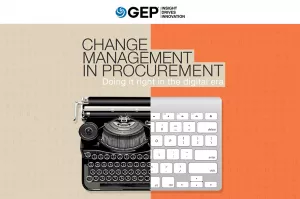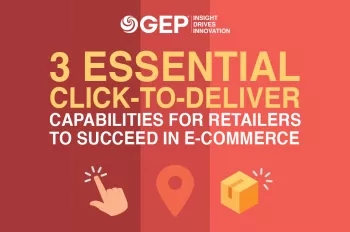According to Gartner, only a third of organizational change efforts are clear successes, with half being clear failures. With emerging technologies powering transformed procurement processes, it’s critical for change managers to understand the true impacts on end users — and to anticipate and overcome the concerns of change resistors.
This timely topic is thoroughly explored in a new white paper from GEP — Change Management in Procurement: Doing It Right in the Digital Era. The paper addresses the biggest challenges facing change management efforts, and also guides procurement leaders to more effectively manage change as a component of digital transformation.
What’s Inside:
- The psychology of change — analyzing, predicting and influencing employee behavior
- The impact of emerging technologies on procurement processes
- The new digital tools for effective communication and user education
A must-read for procurement leaders looking to successfully steer their organizations toward digital transformation.
EXECUTIVE SUMMARY
The future of change management is to change how we manage it. With emerging technologies like artificial intelligence (AI), robotic process automation (RPA) and blockchain enabling the creation of new source-to-pay (S2P) processes — processes that are not just step improvements, but actively create a new digital environment and revolutionize the way procurement operates within it — it becomes ever more critical for change managers to understand the true impacts of change on end users and find innovative ways to drive adoption.
For decades, traditional change management practices have underplayed the importance of psychological aspects involved in accepting change. Understanding and relating to the mind of a change resistor is paramount to successfully drive digital transformations in the future. Subsequently, there is also a growing need to enhance communication and learning methods, and leverage these as enablers of change adoption.
Age-old email communication with catchy subject lines, designed for mass audiences, are a thing of the past and should be replaced by more interpersonal communication methods. Similarly, traditional learning methods are known to be resource-heavy and inefficient, with slow returns on investment. This paper focuses on addressing all the above challenges, and guides procurement leaders and change managers to more effectively manage change as a component of their digital transformations.

WHAT IS CHANGING IN THE PROCUREMENT PROCESS?
Companies with a “Digital First” attitude will leverage existing and emerging technologies such as artificial intelligence, cloud-based solutions, advanced predictive analytics, cognitive computing, and natural language processing to create innovative and competitive processes, products and services.
Source-to-Contract (S2C)

While the initial belief may be that S2C activities are strategic, and therefore must require human intervention, there are areas where technology will drive change. There will be a high level of artificial intelligence (AI) embedded in the development of sourcing strategies. Currently, advanced spend analytics, opportunity identification and external/market insight development are completed by humans. In the future, AI will enable these activities and bring insight back to category managers to vet with their teams.
Additionally, previously mundane tasks like contract metadata extraction are being replaced with Optical Character Recognition (OCR) technology, making contract searches easier. Front-end “self-service” scorecards will allow suppliers to provide up-to-date information that allows supplier risk assessments and performance management to be automated. This will minimize or eliminate the need for dedicated supplier relationship management roles.
Procure-to-Pay (P2P)
The procure-to-pay process, including tactical purchasing, has never been an area of glory. Long burdened with manual, repetitive tasks, the P2P function is starting to see a dramatic impact introduced by emerging technologies. Industry reports vary, but an average of 60 percent reduction in P2P related resources is expected as manual processes are replaced by a combination of robotic process automation (RPA) scripts and bots.
There are significant future impacts on procurement with advancements such as blockchain and smart contracts, but for most organizations these are still several years down the road. However, steps must be taken now to prepare the organization, and most importantly the data, for future technology plays.
PERCEPTION AND PRACTICALITY
Human beings are hard-wired to seek comfort and stability, and are willing to work toward a status quo that brings them there with minimum uncertainty. Therefore, change is not innately desirable for the typical individual. However, progress brings change and requires humans to adapt and grow.
Technology has brought about radical changes in lifestyles and business. The ability of organizations to leverage new technology, while maintaining costs and successfully managing change at the enterprise, individual and leadership levels, determines their future.
As increasing costs of technological transformation make it tricky for enterprises to remain competitive, it is now more vital than ever to future-proof the change plan. Understanding the psychology of change, and the impact of technology on both process and change management, is at the core of exemplary transformation. In the next few sections, we guide you through three concepts:
- The psychology of change — analyzing, engaging and predicting employee behavior
- The impact of emerging technologies on procurement
- The impact of emerging technologies on change management
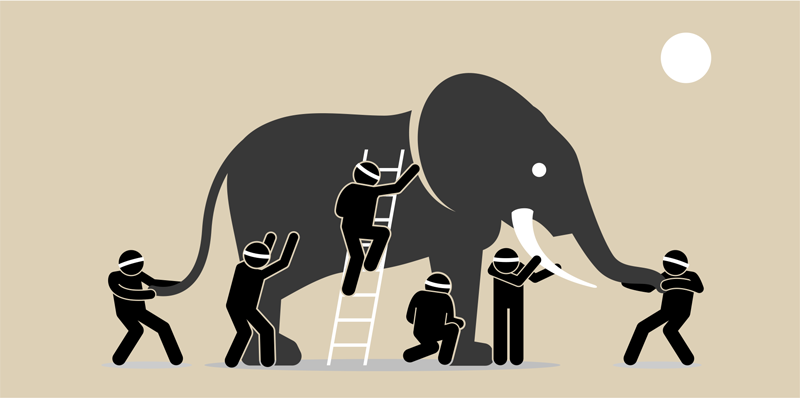
THE PSYCHOLOGY OF CHANGE
CHANGE AGENTS: THE KEY TO SUCCESS
Change generates new knowledge that needs to be transferred to the target audience. While the project manager controls and coordinates all workstreams, change agents are in charge of maintaining contact with the target audience responsible for change adoption within their teams.
In a typical procurement function, change agents are in one of the following roles:
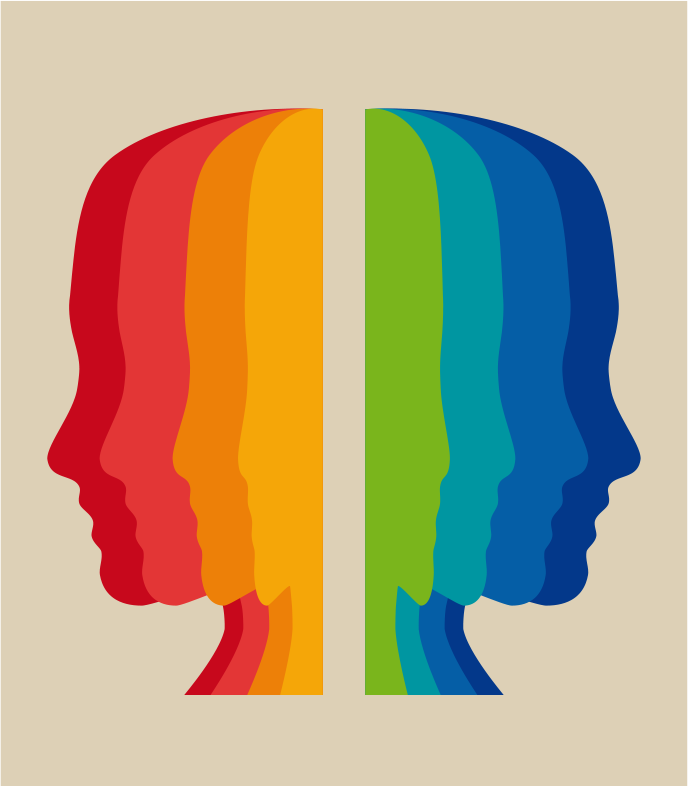
- Office administrators
- Power users — S2C (analysts, category managers, etc.)
- Power users — P2P process (requisitioners, goods receivers, etc.)
Traditionally, a change management plan comprised three workstreams to comprehensively implement a change: target audience analysis, communication, and training. In conjunction with each other, these three components have helped accomplish change engagements for organizations of all sizes.
Historically, the missing and unspoken element across all technological transformations has been empathy. Employees have been treated merely as machines that should change at the press of a button. To take a proactive rather than reactive approach in managing change, it’s vital to understand the reasons for change resistance and impact on the mind of a change resistor.
INSIDE THE MIND OF A CHANGE RESISTOR
There’s a set of typical questions that run in the mind of a change resistor upon hearing rumors of change:
- What is changing? I hope it does not affect me.
- Can I cope with the changes?
- Will the changes impact my job performance?
- Will I be able to match my peers adapting to these changes?
Renowned chartered psychologist John M. Fisher developed “The Process of Transition,” a brilliant analysis of personal change:
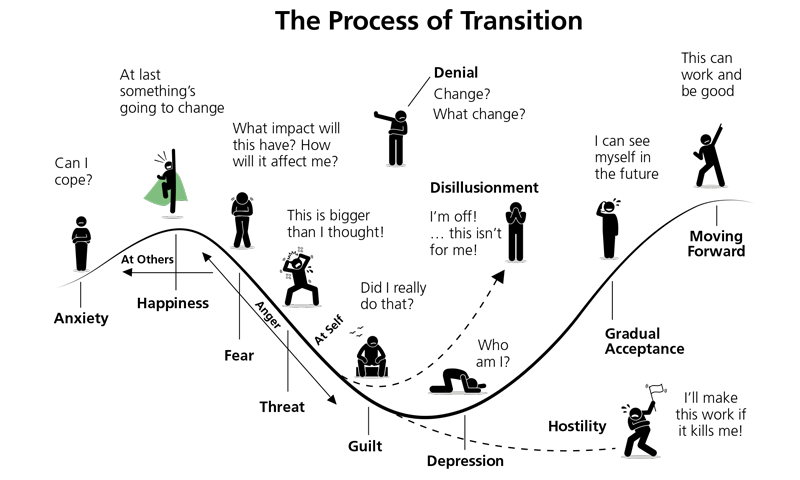
A change manager’s objective is to control the process of transition to guard against disillusionment or hostility because of the uncertainties involved. Effective training and communication methods play a key role as individuals transition from anxiety through gradual acceptance to reach the steady state of “moving forward.”
REASONS FOR RESISTANCE TO CHANGE
We know that resistance to change is an intuitive human reaction. The reasons for the resistance can be simplified into the following two groups:
- Psychological
- Leadership/Organizational
Psychological
The activity inside the mind of a change resistor is trickiest for change managers to successfully understand. Being able to predict resistance, plan responses and influence human behavior is the ultimate objective of a change manager.
Following are the top reasons for resistance to change typically found among personnel across multiple industries:
- Ambiguity about the need for change
- Exclusion from change-design discussions
- Change in routines — stepping out of comfort zones
- Lack of visibility into the benefits and rewards of change
- Concerns with competence
- Increased workload — in addition to current responsibilities
Leadership/Organizational
“Leadership and learning are indispensable to each other.” – John F. Kennedy
The foundation of all change efforts is the trust between employees and their leaders. The change manager’s responsibility here is to help construct this bridge of trust between the leader and the employee. Lack of trust to successfully implement a change management plan is a critical factor, and often the root cause of dissatisfaction among resistors. However, here a few of the other top resistance factors:
- A company’s history of dissatisfactory change implementations — people, process and technology
- Organizational culture and mindset
- Lack of communication between leaders and employees
- A too-short change timeline
- Lack of support before, during and after change (in previous implementations)

EMERGING TECHNOLOGIES AND THEIR IMPACT ON PROCUREMENT
It’s critical for change managers to understand the overall impact of changes resulting from implementation of emerging technologies. The expected changes would be centered around process, technology, organization and employee skillsets. Several roles in procurement will be directly affected by these changes. These roles are the ones that serve as the targeted audience for change management initiatives.
PROCESS AND TECHNOLOGY CHANGES
Artificial Intelligence (AI) and Robotic Process Automation (RPA)
RPA is anticipated to be used in conjunction with AI for most procurement transformations and has change impacts in both S2C and P2P:
| S2C Activities | Change Impact |
| Spend analysis and opportunity assessment | Minimizes manual effort to cleanse, normalize and classify spend data; reduces effort in identification and prioritization of opportunities |
| Generate RFX | Category/sourcing managers simply specify category/subcategory and potential suppliers to be sourced. Manual effort to create RFXs will discontinue apart from basic inputs on requirements |
| Interact with suppliers | Eliminates the need for a person (buyer, sourcing lead) to answer supplier queries |
| Score and receive supplier responses RFx analysis gets automated, resulting in faster decision-making | RFx analysis gets automated, resulting in faster decision-making |
| Reverse auctions | Role of the human gets reduced to an administrator providing very basic details to the RPA system. E-auctions are conducted and analyzed automatically |
| Reporting and analytics | On-demand reporting for spend and contract management; significant reduction in time and effort to create reports manually |
| Contract creation/ drafting | Eliminates manual effort required for searching/creating contract templates and clauses |
| Contract optimization | Eliminates the need to analyze contracts manually for SLA adherence |
| Contract data extraction | Manual step of metadata extraction after uploading contract gets eliminated |
| Identification of supplier risk | Quicker and easier access to supplier risk information — similar to credit rating information available today — resulting in quicker decision-making and supplier selection |
| P2P Activities | Change Impact |
| Guided buying | Improves the efficiency of procuring goods and services |
| Requisitioning | Automated requisitioning eliminates the need to spend man-hours on manual creation |
| Review of requisitions | Spend compliance is driven at the requisition stage and eliminates the need for approvals downstream |
| Purchase order (PO) creation | Automated PO processing eliminates the need to spend man-hours on this activity |
| Clearing goods receipt/ invoice receipt | More efficient invoice matching without the need to manually match invoices |
Blockchain
Blockchain has change impacts anticipated mainly in P2P:
| P2P Activities | Change Impact |
| Invoicing | More secure, autonomous and efficient transactions between buyer and supplier |
| Requisition-to- pay process | Improved transparency, auditability, less manual work without need for documentation, improved trust between buyer and seller. With more transparency, it will be easier to audit, process bills, settle disputes and bolster faith among stakeholders |
ROLE CHANGES
Resources will evolve into more strategic roles; mundane tasks will be automated; and new processes will generate a need for new roles.
Information Technology Roles:
- Information Technology Roles:
- Fewer IT resources will be required as cloud-based solutions are managed by the solution provider.
- Digital transformation IT strategists (a new role) will oversee the creation of the digital transformation road map. They will work with procurement to identify potential solutions based on customer and stakeholder needs.
- Technology SMEs will focus on emerging technology applications and support.
- Process and Technology Centers of Excellence (COE): Emerging COE teams will include process and configuration managers who are well-versed in each process step and highly trained in new technology implementations.
- Analytical Roles: New hires in these roles will require business analytics, deep-data mining, data science and predictive analytics skills.
- Source-to-Pay Roles:
- SRM Managers: With tools to support automated supplier tiering, supplier KPI self- reporting, automated invoicing and payment authorizations, the supplier relationship manager, armed with facts and knowledge, will evolve to focus on strategic supplier relationships, stakeholder engagement, innovation and supplier performance risks.
- Procurement Operations: RPA and AI tools will automate tactical sourcing requests, integrate with Amazon-like tools to proactively identify and channel spend, and automatically perform quality checks. Some resources will be redeployed to new roles.
- Master Data: Technology solutions will capture initial and updated master data from suppliers and facilitate reviews and approval. Spend data will be updated more frequently with organization-specific spend hierarchies, and web search functionality will replace catalog creation and maintenance using blockchain. Master data management (MDM) will leverage bots to input remaining master data. MDM teams will perform quality reviews.
- Sourcing Managers: Guided buying and automated triage, RPA/AI-driven opportunity assessments, automated RFQ/RFIs, automated stakeholder follow-ups on scoring, automated contract template creation, automated contract risk assessment and collaborative redlining elevate the sourcing manager’s role to strong negotiator.
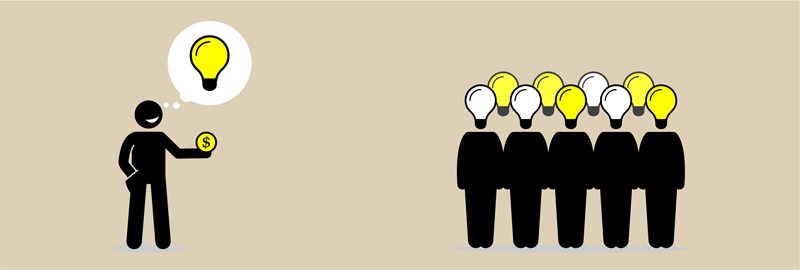
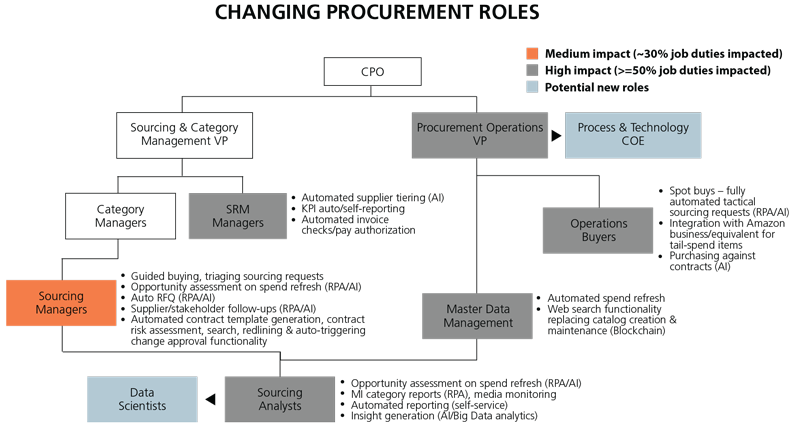
EMBRACING TECHNOLOGY TO MANAGE CHANGE
CHANGE IN COMMUNICATION METHODS
Among all the factors that contribute to a typical change management plan, communication is at the center. In today’s digital era, with information available at our fingertips, an individual’s learning habits have evolved and so should the communication channels.
The need for quicker, smarter and more convenient modes of communication, such as those available outside the working environment, are driving the new reality far beyond traditional, text- based email. These include:
- Instant Support (Chatbots): As consumers’ attention spans shorten and they get habituated to conveniently accessible support, there is a need for on-demand help desk availability. AI and machine learning now enable bots to hold varying natural chats and evaluate the needs of a requester.
Application: An RFx event creator can ask a chatbot, “What are the currencies supported by this platform?” and expect a list of currencies in return. - Infographic and Interactive Communications: Studies show that people remember only 10 percent of what they hear and 20 percent of what they read, but 80 percent of what they see. Infographics help communicate maximum information while taking up limited amount of space and pleasing the eye.
Application: The multilevel serial or parallel process of project milestone approvals can simply be communicated using infographics. - Social Media Adoption: Expanding from its current B2C market, social media is poised to take over B2B and intra-company communications. Already adopted by a few large organizations, its strength lies in the online community format as the vehicle for concise, easily accessible, and action-driven messages in both project-related and social contexts.
Application: Applications like Slack make work-related collaboration simpler using file sharing, organized conversations, searchable history, and voice/video calls. - Improved Storytelling: Virtual-reality technologies facilitate easy, emotional connection building by immersing a user into a virtual model of a proposed plan. This helps greatly to bridge the communication gap between designers and perceivers across multiple industries.
Application: A factory employee can be trained using cost-effective, low-risk, and convenient virtual machinery built in the virtual reality space.
CHANGE IN LEARNING METHODS
“The ability to learn faster than your competitors may be the only sustainable competitive advantage.” — Arie de Geus (head of Shell’s Strategic Planning Group, 1989)
As a part of the traditional Learning & Development (L&D) strategy, instructor-led learning methods have been in use for the longest time. While best known for their ability to create a direct “instruction-feedback” loop in the classroom, they have their shortcomings: expansive resource requirements and long-term return on investment. Emerging technologies are taking us toward a more experiential learning system, transforming L&D using new approaches/tools that include:
- LMS Systems (eLearning): Cloud-based Learning Management Systems, already in use at multiple organizations, transform classroom training into an on-demand service. This model gives trainees the flexibility to learn at their own pace and convenience (mobile learning).
Application: Use of SaaS platforms that provide self-learning environments at low cost will drive down training costs while improving effectiveness. - Microlearning: Microlearning is a corporate education strategy that promotes learning in short, bite-sized and logically structured lessons. Learning is no longer restricted to an individual’s professional workplace, but goes beyond to impact lifelong education.
Application: Learning courses designed using microlearning techniques such as scenario-based chapters, gamified activities, and high-impact contextual imagery will drive engagement. - Virtual and Augmented Reality Avatars: Virtual instructor-led training allows for leveraging a trainer’s knowledge and body language to build on-demand courses. In addition, several industries benefit by reproducing a virtual first-person view of any professional work environment to train at convenience with minimal supervision.
Application: Instructor-led, global training sessions hosted remotely to trainees via VR and reproduction of heavy-machinery operation using AR make learning safe, easy and cost-effective. - Artificial Intelligence: Evaluating an employee’s learning patterns to auto-customize courses and maximize learning is how AI will impact corporate employee training today and through the next decade. With personalized tests and quizzes with measurable returns for business, the future of training is reinforced with AI technologies.

CONCLUSION
To transform a procurement enterprise into a change- and technology-friendly organization, we recommend the following practices:
- Embrace empathy as a new arm of the organizational change management workstream focusing on the psychology of change. The objective of this extension will be to:
- Understand and predict human behavior under unforeseen circumstances
- Acknowledge reasons for change resistance
- Proactively plan to comprehensively respond to change resistance
- Understand and integrate emerging technologies such as AI, RPA and blockchain. In addition, drive awareness and address the change impact with affected audiences such as suppliers, business stakeholders, category managers and other procurement professionals.
- Transform change management techniques by leveraging the latest communication and training technologies. Mass technological change management projects stand to benefit by building relatable, user-friendly, convenient and cost-effective modes of learning and communication.
Theme: Strategy and Planning

